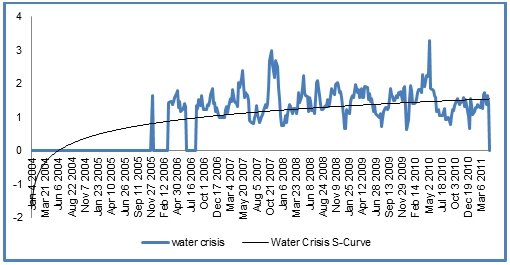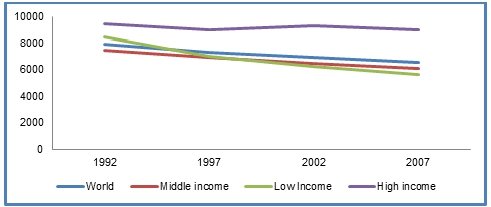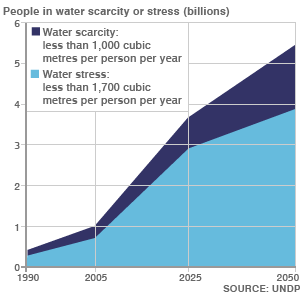A shortage of water resources could spell increased conflicts in the future. Population growth will make the problem worse. So will climate change. As the global economy grows, so will its thirst. Many more conflicts lie just over the horizon. – Ban Ki-moon (Lubin, 22 March 2011)
Water crisis has serious implications that may cause concern of water security as a scarcity of water will escalate to regional unrest, conflict, and instability. Water crisis is measured by considering the relative availability or scarcity of water to the total population. Water crisis was a looming issue in the 1990s when it was predicted that the next two decades would see severe crisis for water in poorest of the countries (Crossette, 10 August 1995).
According to the UN data, access to freshwater is unavailable to more than one in six people globally i.e. is estimated to be 894 million (UN Water, 2011). More than 1 million people globally do not have access to safe drinking water (WHO, 2011). 2 million people die every years due to lack of sanitation and one of the diseases that causes maximum amount of death is diarrhea that occurs due to drinking of unsafe water (WHO, 2011). An estimated amount of 2.6 billion people lack improved sanitation (WHO/UNICEF, 2010).
According to forecasts, by 2025 water stress would affect almost two third of the world population (Clinton, 22 March 2011). This emerging trend of water crisis is expected to have serious implications for “increasing unrest, conflicts, and instability over water” (Clinton, 22 March 2011). Water crisis is an evolving issue and therefore requires a trend analysis in order to judge its potential impact on humanity. This report traces the trend of water crisis and its implications to health and security hazards globally.

The above figure shows the awareness of water crisis and security concern through occurrences of the key word search in Google trend. Trend line for the number of occurrences each dates since 2004 is considered. The trend lines show that the awareness for water crisis and security are still at the nascent stage with very few searches occurring in the internet on the topic. Therefore, the position of the trend on the S-Curve is still emerging, with the trend having great value and reason for concern.
Using Voros’s (2003) generic foresights model, the paper will further analyze the future of a water crisis and the way it may have implications for security. Using this model, the analysis of the water crisis situation can be delineated into four stages of understanding – (1) what is presently happening, (2) what seems to be happening, (3) what actually is happening, and (4) what might happen in future.
The first phase of analysis would be to understand what is going on right now.

Clearly, the resource for freshwaters is reducing continuously showing a declining trend. The decline in the availability of freshwater to the increasing population pressure would result in a higher degree of pressure on available water resources. Therefore, there is an expected water scarcity and there is an evident inequality in the scarcity phenomenon, with the richer countries having greater access to water while the low income countries have the least access to it.

With the present stress on the water, scarcity and international organizations like the UN and governments are trying to counter the threat that is imposed through a growing scarcity of water. The water sources available to the percentage of the population in the world has improved from 1996 through 2008, however, there are still approximately 40 percent population in the low income regions of the world that do not access to improved water sources.
This is a worrying aspect for the scarcity of water will lead to greater conflict for water. An inequality in the availability of water and sanitation is also observed with low-income countries having less population with access to water and sanitation and the richer countries having greater access.

The problem of water availability is higher in poorer countries and is acute in arid and dry regions of the world as in case of Sub-Saharan belt, or South Asia (see figure 4). The problem of water scarcity is expected to intensify in future with the availability of water per person per year is expected to decline (see figure 5).

The problem of ware scarcity has two-way implications –
- This will trigger serious health concern and human development issues with a large chunk of the global population not having access to safe drinking water.
- Due to regionalization of the water scarcity and abundance of water resources, the next trend would be massive migrations to areas where water is less scarce. This may lead to conflict and regional instability.
The increase in global population, that is expected to reach 7.9 billion in 2050 will increase the global economic activity and therefore, would increase the amount of demand for water. As agriculture is the sector that uses maximum water resources, with increase in population will face a dual pressure of producing more and water scarcity due to unavailability of irrigational water. Further, the urban areas will face greater impact as the demand for urban water will increase due to high migration from rural to urban areas. Therefore, water scarcity issue is a problem for all nations as this is expected to trigger national and regional instability and conflict in future.
References
Clinton, H. R., 2011. Remarks on World Water Day. Web.
Crossette, B., 1995. Severe Water Crisis Ahead for Poorest Nations in Next 2 Decades. Web.
Google Trend, 2011. Google Trend. Web.
Lubin, G., 2011. A graphic look at the world water crisis. Web.
U. N. Water, 2011. Drinking Water and Sanitation. Web.
Voros, J., 2003. A Generic Foresight Process Framework. Foresight , 5(3), pp.10-21.
WHO/UNICEF, 2010. Progress on Sanitation and Drinking-water. Web.
WHO, 2011. Water Sanitation and Health. Web.
World Bank, 2011. World Databank. Web.